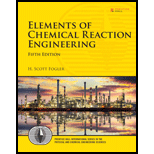
(a)
Interpretation:
The reactor which is better among CSTR and PFR with perfect conditions is to be stated.
Concept Introduction:
The conversion, X can be defined as the moles of any species A that are reacted per mole of A fed in the reactor.
The full form of CSTR is Continuous-Stirred Tank Reactor. This reaction has its application in the industrial processes. This reactor actually used for liquid-phase reactions.
The full form of PFR is Plug-Flow Reactor which consists of a cylindrical pipe and it is used for the gas-phase reactions.
(b)
Interpretation:
The time taken by the
Concept Introduction:
The conversion, X can be defined as the moles of any species A that are reacted per mole of A fed in the reactor.
The full form of CSTR is Continuous-Stirred Tank Reactor. This reaction has its application in the industrial processes. This reactor actually used for liquid-phase reactions.
The full form of PFR is Plug-Flow Reactor which consists of a cylindrical pipe and it is used for the gas-phase reactions.
(c)
Interpretation:
The time taken by the
Concept Introduction:
The conversion, X can be defined as the moles of any species A that are reacted per mole of A fed in the reactor.
The full form of CSTR is Continuous-Stirred Tank Reactor. This reaction has its application in the industrial processes. This reactor actually used for liquid-phase reactions.
The full form of PFR is Plug-Flow Reactor which consists of a cylindrical pipe and it is used for the gas-phase reactions.
(d)
Interpretation:
The obtained conversions if CSTR and PFR connected in series at
Concept Introduction:
The conversion, X can be defined as the moles of any species A that are reacted per mole of A fed in the reactor.
The full form of CSTR is Continuous-Stirred Tank Reactor. This reaction has its application in the industrial processes. This reactor actually used for liquid-phase reactions.
The full form of PFR is Plug-Flow Reactor which consists of a cylindrical pipe and it is used for the gas-phase reactions.
(e)
Interpretation:
The volume of the batch reactor that is required to process the same concentration of A per day to achieve
Concept Introduction:
The conversion, X can be defined as the moles of any species A that are reacted per mole of A fed in the reactor.
The full form of CSTR is Continuous-Stirred Tank Reactor. This reaction has its application in the industrial processes. This reactor actually used for liquid-phase reactions.
The full form of PFR is Plug-Flow Reactor which consists of a cylindrical pipe and it is used for the gas-phase reactions.
(f)
Interpretation:
The sentences which give the description for the learning done by this problem and about the points of problem are to be stated.
Concept Introduction:
The conversion, X can be defined as the moles of any species A that are reacted per mole of A fed in the reactor.
The full form of CSTR is Continuous-Stirred Tank Reactor. This reaction has its application in the industrial processes. This reactor actually used for liquid-phase reactions.
The full form of PFR is Plug-Flow Reactor which consists of a cylindrical pipe and it is used for the gas-phase reactions.
(g)
Interpretation:
The application of the six ideas that is given in table on this problem is to be stated.
Concept Introduction:
The conversion, X can be defined as the moles of any species A that are reacted per mole of A fed in the reactor.
The full form of CSTR is Continuous-Stirred Tank Reactor. This reaction has its application in the industrial processes. This reactor actually used for liquid-phase reactions.
Want to see the full answer?
Check out a sample textbook solution
Chapter 5 Solutions
Elements of Chemical Reaction Engineering (5th Edition) (Prentice Hall International Series in the Physical and Chemical Engineering Sciences)
 Introduction to Chemical Engineering Thermodynami...Chemical EngineeringISBN:9781259696527Author:J.M. Smith Termodinamica en ingenieria quimica, Hendrick C Van Ness, Michael Abbott, Mark SwihartPublisher:McGraw-Hill Education
Introduction to Chemical Engineering Thermodynami...Chemical EngineeringISBN:9781259696527Author:J.M. Smith Termodinamica en ingenieria quimica, Hendrick C Van Ness, Michael Abbott, Mark SwihartPublisher:McGraw-Hill Education Elementary Principles of Chemical Processes, Bind...Chemical EngineeringISBN:9781118431221Author:Richard M. Felder, Ronald W. Rousseau, Lisa G. BullardPublisher:WILEY
Elementary Principles of Chemical Processes, Bind...Chemical EngineeringISBN:9781118431221Author:Richard M. Felder, Ronald W. Rousseau, Lisa G. BullardPublisher:WILEY Elements of Chemical Reaction Engineering (5th Ed...Chemical EngineeringISBN:9780133887518Author:H. Scott FoglerPublisher:Prentice Hall
Elements of Chemical Reaction Engineering (5th Ed...Chemical EngineeringISBN:9780133887518Author:H. Scott FoglerPublisher:Prentice Hall
 Industrial Plastics: Theory and ApplicationsChemical EngineeringISBN:9781285061238Author:Lokensgard, ErikPublisher:Delmar Cengage Learning
Industrial Plastics: Theory and ApplicationsChemical EngineeringISBN:9781285061238Author:Lokensgard, ErikPublisher:Delmar Cengage Learning Unit Operations of Chemical EngineeringChemical EngineeringISBN:9780072848236Author:Warren McCabe, Julian C. Smith, Peter HarriottPublisher:McGraw-Hill Companies, The
Unit Operations of Chemical EngineeringChemical EngineeringISBN:9780072848236Author:Warren McCabe, Julian C. Smith, Peter HarriottPublisher:McGraw-Hill Companies, The





